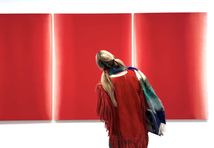Arts and Sciences: Bridging the Gap
- The Courtauldian
- Oct 22, 2017
- 4 min read

Illustration by Matthew Page.
Are you left-brained or right-brained? Are you more analytical and logical in your thinking, or more intuitive and imaginative? This concept of the brain having a dominant hemisphere has pervaded popular culture since it was first proposed in the 1960s. While it is true that the two halves of the brain are different from each other and process different sorts of information, is one really dominant over the other? This is not so. In fact, neuroscientific research has shown that there is no evidence that our brains favour one side. In any given situation, both halves of the brain are complementary, and engaged in interaction. For example, the right brain may allow you to recognise a colour, but the left side of the brain assigns a name to this, such as “blue.” However, the idea of having a dominant half of the brain continues to exist and impact how we view human nature.
The separation of the creative and scientific mind is starkly highlighted in the world of academia. Bachelors’ and Masters’ degrees are often in the arts or the sciences, with academic subjects divided up between the two. There seems to be a cultural and academic belief that the two are separate entities and do not overlap. But why are they separated? Why are we made to believe that you cannot do both? Where does that leave those of us that identify as both creative and scientific? Personally, I often feel caught between the two worlds, belonging to both while not entirely exclusive to either.
I am American and went to a liberal arts university in the U.S. Unlike in the U.K., American undergraduate students generally do not apply to a particular course within a university, but rather to the singular undergraduate college of the university – often called the college of arts and sciences. The primary course of study (one’s 'major') is generally not declared until the second or third year, after having taken several classes within that subject. Schools with a focus on liberal arts typically require students to take at least one course in each of a wide variety of subjects. The freedom in this style of education allows students to pursue a variety of interests. Whilst I majored in biology with the intention of going on to medical school, I followed a secondary course of study (a 'minor') in music with a focus on ethnomusicology, and sang in a chamber choir and a jazz band. In my fourth year I was made the producer of a student-run theatre company. Through my participation in these activities, I was fortunate enough to meet many people in the same position as me, who had a foot in both academic hemispheres. I have often wondered where this divide between arts and sciences came from. What should be made of the young woman who double-majored in music and chemistry, and composed a symphony inspired by her chemistry research, before going on to medical school? What about the microbiology students who entered a national competition for bacterial art, wherein pigment-producing bacteria are used to paint pictures on nutrient plates? Or the biologist with a passion for photography that was the creative director of a student-run fashion magazine? Or the computer scientist that ran a breakdancing crew?
I have found that there is no shortage of people that bridge the art-science gap, which made me question why the gap existed in the first place. There is no want for academic literature arguing the benefits of arts and science coalescing. Creative pursuits provide a powerful tool for the communication of ideas, where effective communication (especially to non-scientists) is a huge problem across all fields of science in a world that increasingly depends on scientific advances. Analyzing art and music improves pattern recognition that can have major implications in scientific research. In the other direction, scientific understanding of the production of pigments, from ancient cave art to modern paints to colour-changing hair dyes, makes visual art possible. Advances in scientific technology have greatly enhanced our ability to analyze paintings. Understanding of the physics of light and lenses is essential for photography, just as understanding of acoustics and resonance is vital to music production. There is no end to the intersections of art and science – perhaps exemplified no better than in the golden ratio, a pattern that appears in endless iterations in nature, science, and art.
By all of this, I do not mean to suggest that the entire structure of educational institutions should be radically changed, nor do I think everyone should be required to take an interest in both art and science. I merely intend to highlight an unfortunate separation of two intrinsically linked fields. There is an art to science and a science to art - they are not separate worlds at all, but overlap and intersect infinitely and beautifully. Just like the human brain, neither hemisphere is complete without the other.
Jack Villani is a recent graduate of the Masters programme in Medical Microbiology at the London School of Hygiene and Tropical Medicine.












Comments